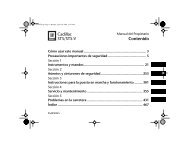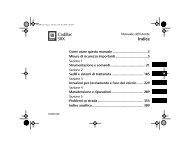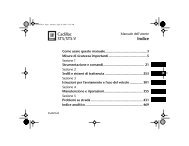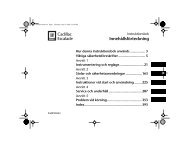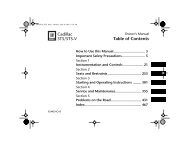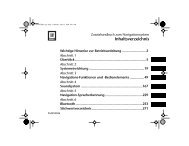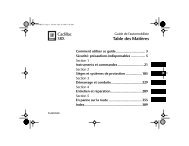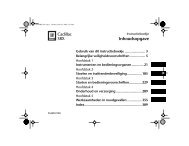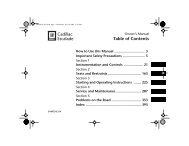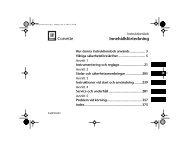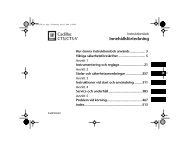Owner's Manual Cadillac BLS - IFS Europe BV
Owner's Manual Cadillac BLS - IFS Europe BV
Owner's Manual Cadillac BLS - IFS Europe BV
Create successful ePaper yourself
Turn your PDF publications into a flip-book with our unique Google optimized e-Paper software.
460_OM_MY09.book Page 211 Wednesday, April 2, 2008 10:32 AM<br />
Car care<br />
211<br />
Note: Low tyre pressure also causes premature<br />
tyre wear and increased fuel consumption.<br />
Tyre pressure should match the current<br />
load and speed of the car, see page 245.<br />
The tyre pressures given apply to cold<br />
tyres, that is they have the same temperature<br />
as the outside air temperature.<br />
The pressure increases approximately<br />
0.3 bar (4 psi) as the tyres become warm<br />
(e.g. during fast motorway driving). When<br />
the temperature of the tyres changes by<br />
10 °C, the tyre pressure will change 0.1 bar<br />
(2 psi).<br />
Never reduce the pressure of a hot tyre. If<br />
the tyres are hot when you check them, only<br />
increase the pressure, if necessary.<br />
Underinflated tyres wear more quickly than<br />
slightly overinflated tyres.<br />
If a valve is leaking, simply unscrew it and fit<br />
a new one.<br />
Note: Remember to adjust the tyre pressures<br />
if you change the load in the car significantly<br />
or intend to drive at substantially<br />
lower or higher speeds than normal.<br />
Shifting the wheels<br />
WARNING<br />
When fitting just one new pair of tyres,<br />
these should be fitted to the rear wheels,<br />
as these are more critical to the directional<br />
stability of the car (e.g. on braking<br />
or in a skid). The existing rear wheels<br />
should therefore be moved to the front.<br />
Always move rear left to front left and rear<br />
right to front right, so that the direction of<br />
rotation remains the same.<br />
Because the car has front-wheel drive, the<br />
front tyres tend to wear faster than the rear<br />
ones. New tyres should always be fitted in<br />
pairs, so that tyres on the same axle have<br />
the same amount of tread.<br />
Mark the wheels L (left) and R (right) when<br />
changing between summer and winter<br />
tyres. This ensures that the direction of rotation<br />
of the wheels is the same when they are<br />
refitted. Fit the tyres in best condition to the<br />
rear wheels.<br />
Store wheels either lying flat or hanging –<br />
never standing upright.<br />
Tyre markings<br />
Tyre marking 215/55 R16 93V means:<br />
215 Tyre section width, mm<br />
55 Aspect ratio, i.e. the section height<br />
as a percentage of the section<br />
width<br />
R Radial ply<br />
16 16 in. wheel rim diameter at bead<br />
seats<br />
93 Tyre load index<br />
V Speed rating<br />
Tyre load indices<br />
91 Tyre approved for max. 615 kg<br />
93 Max. 650 kg<br />
94 Max. 670 kg<br />
95 Max. 690 kg<br />
97 Max. 730 kg<br />
Speed ratings<br />
Q Tyre approved for speeds up<br />
to 100 mph (160 km/h)<br />
S Max. 112 mph (180 km/h)<br />
T Max. 118 mph (190 km/h)<br />
H Max. 130 mph (210 km/h)<br />
V Max. 149 mph (240 km/h)<br />
W Max. 168 mph (270 km/h)<br />
Y Max. 186 mph (300 km/h)




